TurboGrafx-16 Mini Omissions
Top 10 Games Not on the TurboGrafx-16 Mini!
The TurboGrafx-16 Mini was supposed to be Konami’s answer to the miniature console fad. It was slated for release on March 19, but it has been indefinitely delayed due to the coronavirus outbreak. The PC Engine Mini was released in Japan as scheduled and there’s still a chance that we could see the TurboGrafx-16 Mini in the future, so I figure I’d post this list anyway. The TurboGrafx-16 Mini was going to feature nearly 60 pre-loaded games, and the lineup would have included a mixture of English and Japanese titles. It’s hard to find fault with its proposed lineup, but there were a few glaring omissions that were overlooked. It should be noted that we’re not simply listing the best games on the platform. (We’ve already looked at the best TurboGrafx-16 and TurboGrafx-CD games, after all.) This countdown is bound to include a few hidden gems, and we’ll also be shining a light on some of the games that defined the console.
10
Keith Courage in Alpha Zones
1989
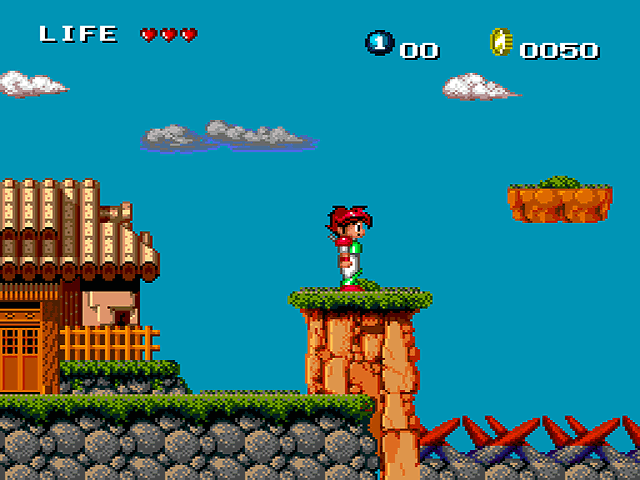
Keith Courage in Alpha Zones is a simple, side-scrolling platformer that was originally released in Japan as Mashin Eiyuden Wataru. It was adapted from an anime of the same name, but the names were changed in the American release to protect the innocent. The premise revolves around a kid name Keith Courage who fights “beastly alien dudes” as he treks through seven stages. At a certain point in each stage, Keith gains access to his robotic “Nova Suit” and ventures into the underworld to face off against more powerful enemies. After defeating each stage boss, Keith returns to the overworld without his suit and prepares for a new set of challenges. This seems like a good time to remind everyone that this isn’t a list of the greatest TurboGrafx games. Keith Courage was mediocre at best, but it’s noteworthy for being the original pack-in game for the TurboGrafx-16 in America. It was customary for system-defining games to be included as pack-in titles (see Super Mario Bros. on the NES and Tetris for the Game Boy), but I don’t think to many Turbo fans were clamoring for Keith Courage. The game deserved a place on the TurboGrafx-16 Mini for historical reasons, however, and I think anyone who plays the game will understand why the system failed to take off in America.
9
It’s Parodius!
1992
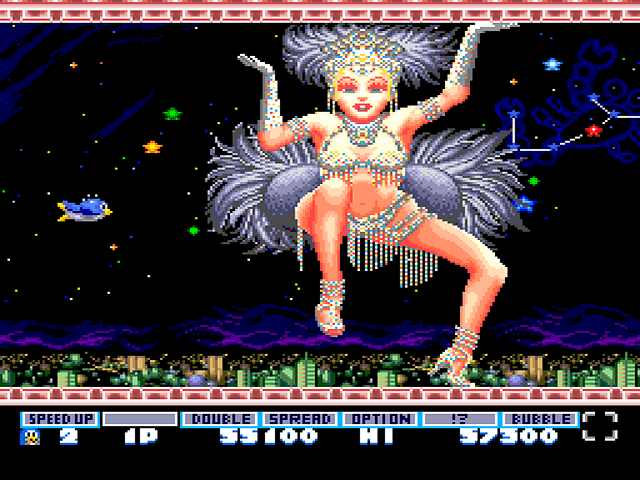
The Parodius games are absurd parodies of Konami’s own Gradius series, but they also incorporate elements from Twinbee, Salamander, and a handful of lesser-known Konami shoot ’em ups. The game plays like a standard shooter for the most part, but the humorous environments and comical characters make everything feel more light-hearted. (The colorful graphics and ridiculous enemies also help in this regard.) It’s Parodius! is intentionally nonsensical, and it’s nice to play a shooter that doesn’t take itself so seriously. It’s hard not to smile when your surrounded by flying penguins and half-naked showgirls. The game isn’t quite as punishing as typical Konami shooters are, and I appreciated the laidback approach. It’s Parodius! on the PC Engine was missing a couple of stages from the arcade game and the graphics were downgraded slightly, but the play mechanics were left in tact and the game was as delightfully ridiculous as it ever was. There are many intense shoot ’em ups on the PC Engine, and It’s Parodius! would have been a perfect way to introduce new players to the genre.
8
Sylphia
1993
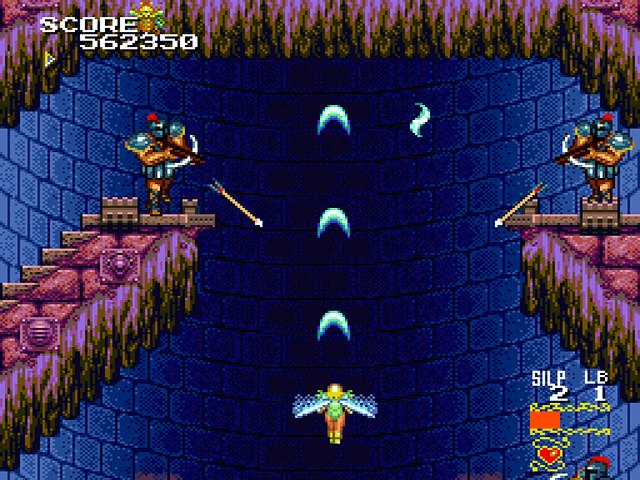
Sylphia is an overhead shooter that’s clearly inspired by Greek mythology. In lieu of spaceships or airplanes, the game focuses on a woman named Silphia who was resurrected as a fairy by the goddess Athena. (I have no idea why Silphia’s name is spelled differently from the title of the game, but it’s best not to worry about these things.) As our winged heroine takes to the skies, she faces onslaughts of mythological monsters ranging from hippogriffs to colossi. Rest assured, Silphia’s well-equipped to deal with these threats. Her weapons are based on the four classical elements, and she’s given ample opportunity to power-up her attacks throughout her journey. Whether you’re lighting up giant minotaurs or taking out groups of harpies with powerful blasts of water, it’s a lot of fun to try out all of your attacks. There are several shoot ’em ups included on the TurboGrafx-16 Mini already, but Sylphia would have been a welcome addition. The game was released exclusively in Japan, it never made it onto the Virtual Console or other download services, and it’s one of the most expensive games for the platform. You can expect to pay $700 or so for a used copy for the game, and that’s if you’re lucky! The TurboGrafx-16 Mini could have given a game like Sylphia more exposure, and there’s no reason why a hidden gem should have to remain hidden forever.
7
The Legendary Axe
1988
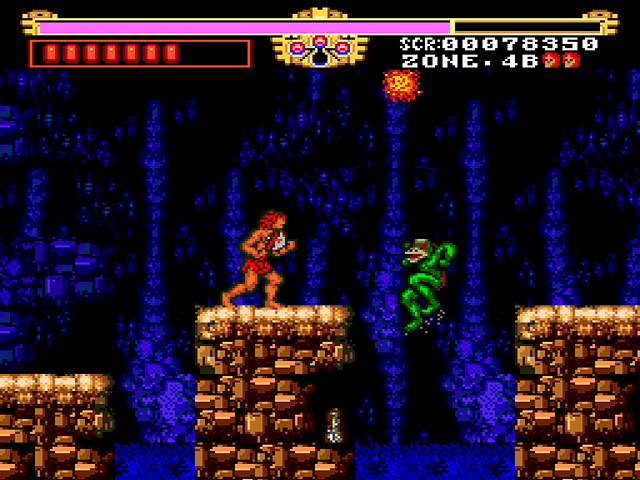
The Legendary Axe is a fantasy-themed side-scroller starring a barbarian that’s decked out in animal skins and armed with a giant axe. The object of the game is to rescue a scantily clad girl from an evil half-beast cult leader, and players will have to collect all sorts of artifacts and power-ups as they work their way through six treacherous stages. Although The Legendary Axe is an action game at heart, there are a few adventure elements thrown in for good measure. For instance, players will be able to find items to increase their health or their attack speed. The jungle environments are alive with detail, and the enemies are impressive too. (During you’re journey, you’ll have to overcome rocks, monkeys, and rock-throwing monkeys!) The Legendary Axe was developed from the ground up specifically for the TurboGrafx-16, but it felt like a proper arcade game. It was one of the system’s most impressive launch titles, and it received high praise from gaming magazines back in the day. (Electronic Gaming Monthly ranked it as the 80th best game of all time in 1997!) It’s a little on the short side, but it’s easy to jump into and it would make the TurboGrafx-16 Mini feel more complete.
6
Dragon’s Curse
1990
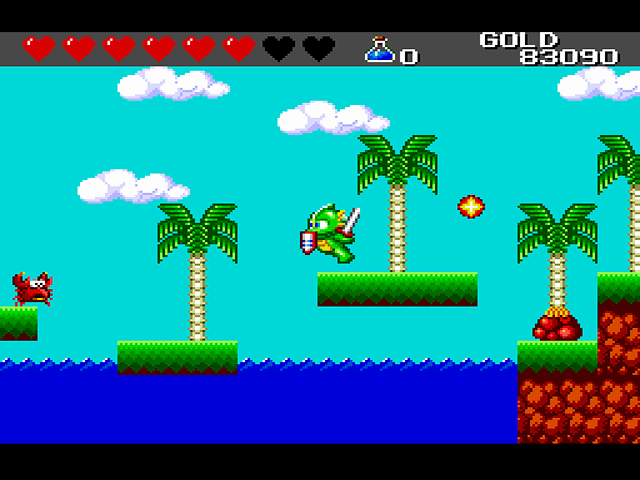
Those of you who have perused our list of best Sega Master System games know that I’m a huge fan of Wonder Boy III: The Dragon’s Trap. The Dragon’s Curse is the same game for the most part, but licensing issues prevented Hudson Soft from using the Wonder Boy name on the TurboGrafx-16. Like most Wonder Boy titles, Dragon’s Curse is a side-scrolling adventure game with fantastic platforming and an emphasis on exploration. The way you progress through the game’s inter-connected areas could be likened to Metroid, but Dragon’s Curse is decidedly more colorful and whimsical. Instead of obtaining new weapons and equipment to reach new areas, players will have the opportunity to transform into various animals. As you venture deeper into the game, you’ll climb walls as a mouse, explore underwater areas as a piranha, and take to the skies as a hawk. There are five animal forms in total (not counting the standard human form), and each new transformation offers new gameplay experiences. The Dragon’s Trap was recognized on this site as the greatest Master System game of all-time, but I think it’s unfortunate that Dragon’s Curse is overlooked on the TurboGrafx. It’s the same great game with more colors, less sprite flicker, and half the calories!
5
Nekketsu High School Dodge Ball Club
1990
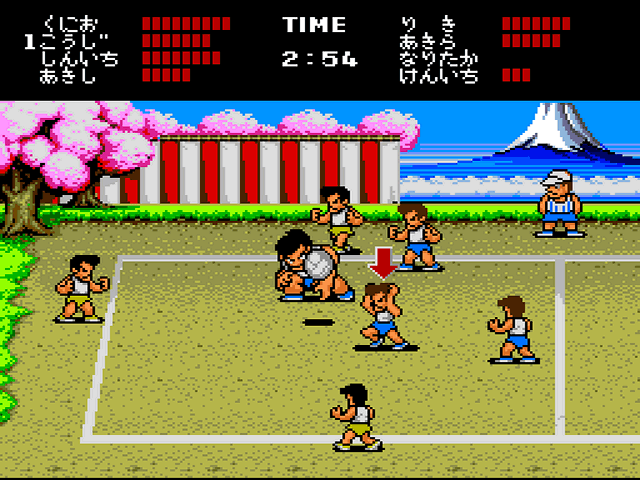
Nekketsu High School Dodge Ball Club is better-known as Super Dodge Ball in the west. The PC Engine version of the game is based off of the original arcade release, and it retains several elements that didn’t make it into the popular Famicom/NES port (including brief cinematic cutscenes and varying character sizes.) The game also took cues from the NES version, and it implemented individual life meters for each character in lieu of using a shared life meter for the entire team. The basic play mechanics aren’t significantly different from one version to the next, though, and the game is still centered around two opposing dodge ball teams who are literally trying to kill each other with the ball. Players have the ability to throw, pass, or catch the ball, and they also have a handful of special throws at their disposal. As players progress through the game, they’ll challenge teams from all over the world and play in a variety of exotic locations. The different environments can have profound effects on how the game is played. For instance, the slippery surface in Iceland makes it hard to get traction while the dirt fields in Africa make it difficult to move at all. The PC Engine version also features a special stage that lets players test their dodge ball skills on the moon! As if this weren’t awesome enough already, Superman himself will fly in and award players with a trophy if they are able to clear this special stage! It doesn’t get much more random than that. Nekketsu High School Dodge Ball Club was released on both HuCard and disc format, and I would have been happy to see either version on the TurboGrafx-16 Mini.
4
Devil’s Crush
1990
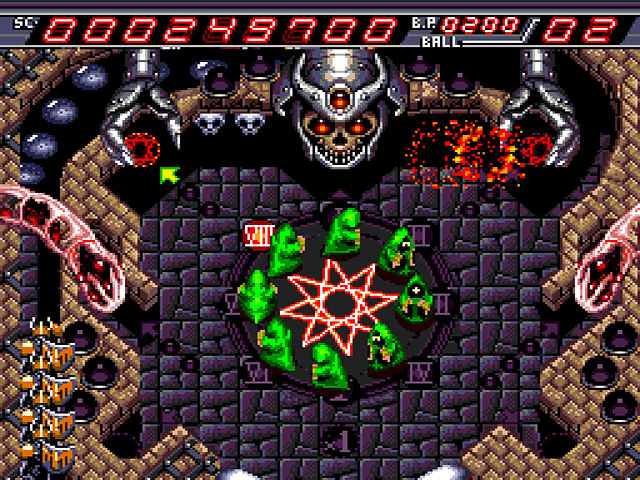
Devil’s Crush (known as Devil’s Crash in Japan) is a fantasy pinball game that’s infused with gothic elements. Instead of trying to replicate real life, the game does things that wouldn’t be possible on an actual pinball table. The screen is crawling with a variety of occult creatures, and players can destroy them with the pinball. If nothing else, trying to pick off wandering skeletons is more interesting than hitting a static bumper over and over again. Most pinball games simply challenge the player to keep the ball in play for as long as possible, but Devil’s Crush offers more depth and fully embraces the video game medium. Alien Crush was rightfully included on the TurboGrafx-16 Mini, but the sequel is better in almost every regard. The playing field in Devil’s Crush is considerably larger, and players can shake the table when they get in a bind. I also prefer the skull motif of Devil’s Crush to the alien theme of its predecessor, and the music is incredibly catchy. There’s nothing wrong with Alien Crush, but the sequel is clearly the best pinball game on the TurboGrafx.
3
Gate of Thunder
1992
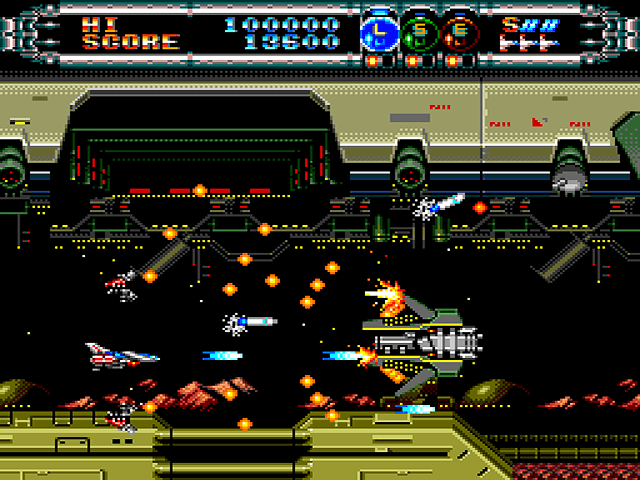
I was happy to see Lords of Thunder on the TurboGrafx-16 Mini lineup, but I’ve always felt that Gate of Thunder was a superior game. The side-scrolling shoot ’em up didn’t make as much of an impact as Gradius or R-Type, but the levels were varied, the bosses were impressive, and the power-ups were plentiful. Whether you were navigating through an asteroid belt or flying through a space station, the game always felt exciting. Gate of Thunder featured some impressive scrolling effects and pseudo 3D graphics, but the game is perhaps best known for its incredible music. Before CG cutscenes were the norm, Redbook audio was arguably the biggest selling point of the CD format. Gate of Thunder‘s award-winning soundtrack helped sell the TurboGrafx-CD, and the game was even included as part of a “4 in 1” pack-in for the TurboDuo in North America. (The other three games included in the bundle were all featured on the TurboGrafx-16 Mini, so Gate of Thunder is an especially glaring omission.) The TurboGrafx had an impressive library of shooters, and Gate of Thunder is arguably the most famous one that was designed specifically for the platform. Unlike Lords of Thunder (which was also released on the Sega CD), Gate of Thunder was a TurboGrafx exclusive!
2
Downtown Nekketsu Story
1993
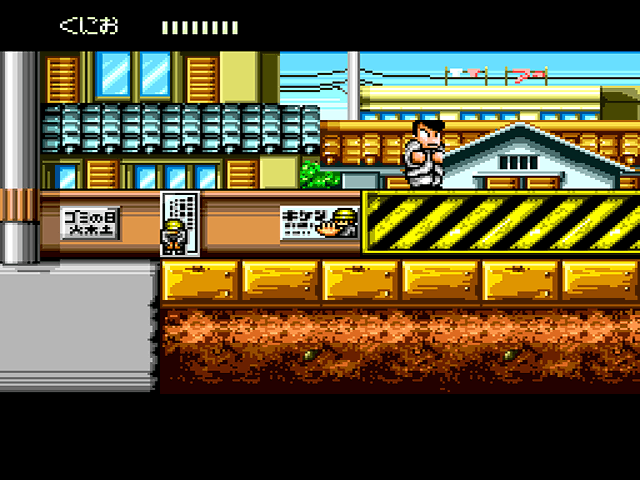
For most people reading this, Downtown Nekketsu Story is better known as River City Ransom. I’ve spoken at length about my love for the game elsewhere on this site, but it’s worthy of the praise. I consider it to be the best beat ’em up of all time and one of the best co-op games ever released. The gameplay could be likened to Double Dragon in many regards, but the open world layout puts it on another level completely. Most games in the genre were designed with arcade audiences in mind, but Downtown Nekketsu Story was clearly intended for the console market. The game had RPG elements that allowed players to improve their stats or learn new maneuvers, and the adventure wasn’t meant to be played through in a single sitting. River City Ransom has already been included as part of the NES Classic, but the PC Engine Super CD-ROM² port deserves to be recognized too. You’d have to put up with some Japanese text, but it won’t take long to get used to characters saying “Gehh!” instead of “BARF!” If nothing else, I think it the entire world should hear the arranged redbook soundtrack. It’s truly something special. The TurboGrafx-16 Mini could obviously have used some more two-player games, and you’d have to look pretty hard to find one that’s better than Downtown Nekketsu Story.
1
Puyo Puyo CD 2
1996
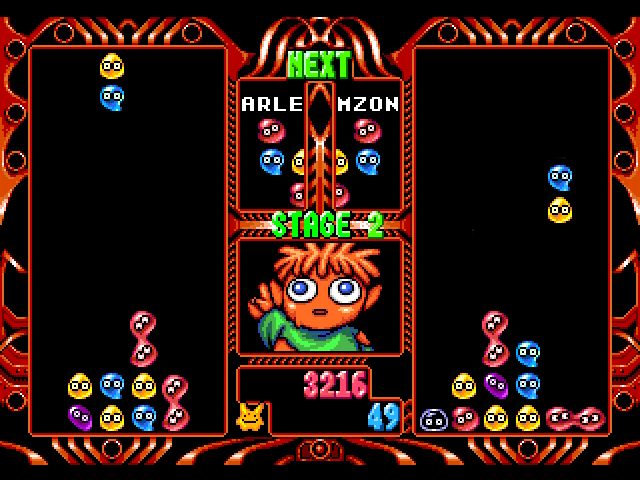
If you’re familiar with mini consoles, you’ve probably noticed how prevalent puzzle games are. The mini versions of the NES, SNES, PlayStation, and Genesis each featured multiple puzzle games, and there are several reasons why. Puzzle games are usually easy to get into but difficult to master. They’re the kind of games that you can play for a few minutes or for several hours, and their “pick up and play” nature makes them ideal for the mini console format. Puzzle games also tend to stand the test of time better than other genres do, and they don’t necessarily rely as much on graphics or cutting edge technology. Finally, most puzzle games have two-player modes, so they provide a reason for the second controller to exist. If I had to choose a puzzle game for the TurboGrafx, there’d be no better candidate than Puyo Puyo CD 2. For the uninitiated, the object of the game is to manipulate falling blobs in order to match up similar colors. It’s a simple concept, but if you plan ahead, you can set up combos and chain reactions. This, in turn, will punish your opponent by dropping garbage onto their playing field. Whether you’re playing against a human opponent or the CPU, Puyo Puyo CD 2 is highly competitive. The game’s Japanese voicework wouldn’t be fully appreciated by western audiences, but it’s certainly not a deal breaker.

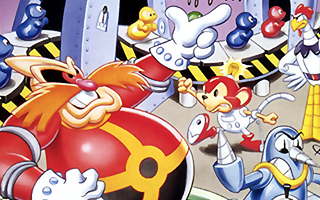
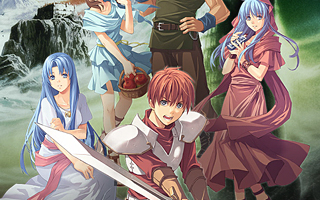
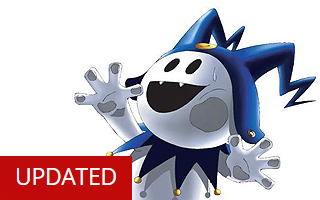
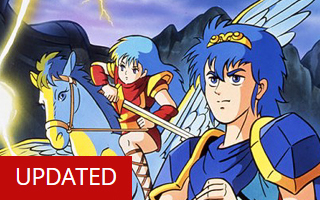
Do you agree with this list? Let us know what you think by leaving a comment below. Your opinion matters!